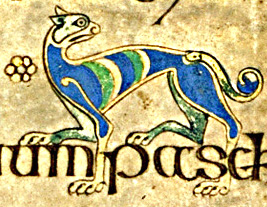Leabhar
Cheanannais
The Book of Kells - Evangelario di San Colombano

xiulong.it texts and
manuscripts digital encoding
Leabhar
Cheanannais |
 |
|
24 Aug 2008
IntroductionLeabhar Cheanannais, best known as "Book of Kells", name derived by Kells Abbey (Mainistir Cheanannais in Irish) where it was conserved for centuries, is an illuminated manuscript, illustred and is a masterwork of Western calligraphy and is the finest example from a group of manuscripts in what is known as the Insular style produced from the late 6th through the early 9th centuries in monasteries in Ireland, Scotland and England and in continental monasteries with Irish or English foundations. Both because of extraordinary technique of realization and exceptional beauty could be consider as one of the most important middleage art work and it would be also widely regarded as Ireland's finest national treasure. Today it is on permanent display at the library of Trinity College in Dublin, catagoed as MS A. I. 58. Leabhar Cheanannais illustrations and decorations overcome in numbers, beauty, complexity, peculiarity and richness any other Insular Evangelarium, and Kells illustration style combines traditional Christian iconography with the ornate swirling motifs typical of Insular art. Figures of humans, animals and mythical beasts together with intricate knotwork and interlacing patterns in vibrant colours enliven the manuscript's pages, morevoer many of these minor decorative elements are imbued with Christian symbolism and so further emphasize the themes of the major illustrations. Book of Kells is composed by 340 vellum leaves or folios, most of them part of wider larger vellum sheets called bifolio: bifolia are bended in half to constitute 2 folios, then each bifolio are nested inside of each other (from 2 to 6 bifolia) bound sewn together constituting a quire; some folios are single sheets, as is frequently the case with the important decorated pages. The folios had lines drawn for the text, sometimes on both sides, after the bifolios were folded. Prick marks and guide lines can still be seen on some pages, and the vellum is of high quality, although the folios have an uneven thickness, with some being close to leather while others are so thin as to be almost translucent. Codex current dimension are 330 by 250 mm., but scholars argued that originally folios were of no standard size, but they were cropped to the current size during an 18th century rebinding. Kells manuscript is in good condition considering its great age, though many pages have suffered some damage to the delicate artwork due to rubbing. This book must have been the product of a major scriptorium over several years yet was apparently never finished, the projected decoration of some of the pages appearing only in outline. Scholars hypothesize that some 30 folios of the original manuscript have been lost over the centuries: in exemple Ussher counted 344 folios in 1621, but several leaves had already been lost by then, while the overall estimate is based on gaps in the text and the absence of certain key |
|
|
|